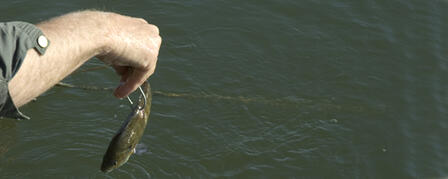KANSAS WILDLIFE, PARKS AND TOURISM COMMISSION MOVES TO PROTECT KANSAS WATERS

Dec. 8, 2011
Wild-caught bait may only be used in waters where caught; other restrictions passed
TOPEKA – During a special public hearing Tuesday evening, Dec. 6, Kansas Wildlife, Parks and Tourism Commissioners acted on regulations governing the use and movement of wild-caught live bait fish and the transport of fish from waters designated as having aquatic nuisance species (ANS) present.
The new regulations change the way Kansas anglers collect and use live bait fish and were approved to curtail the spread of invasive aquatic species — particularly Asian carp, zebra mussels, and white perch — in Kansas lakes and streams. These and other aquatic nuisance species are often spread accidently by people using the state’s lakes and rivers.
The Commission listened to public comments and considered various options before taking action. Commissioners voted on regulations that will take effect Jan. 1, 2012 and will 1) allow anglers to use wild-caught live bait fish only in the pool of a lake or impoundment where taken; 2) prohibit anglers from transporting wild-caught bait fish taken from a flowing stream or river across any dam or natural barrier; 3) prohibit anglers from transporting any live fish upon departure from any ANS-designated body of water; 4) prohibit releasing any fish in department waters (unless the fish was caught from the water into which it is being released), navigable publicly-owned rivers, and federal reservoirs; and 4) require that vessels being removed from all waters of the state have livewells and bilges drained and drain plugs removed before transport on any public highway.
Aquatic nuisance species are animals and plants not native to Kansas that can threaten lake and river ecology, harm native or desirable species, and interfere with the state’s economy. Negative impacts on Kansas waters include, but are not limited to, the following:
- diminished food supplies and degraded habitat for other species;
- reduced numbers and variety of desirable fish;
- reduced fishing and other recreational opportunities;
- lowered property values and decreased quality of municipal water sources;
- fouled water lines, clogged intakes, burned out pumps, damaged power generating facilities, and decreased water system efficiency; and
- increased risk of flooding due to overcrowded biomass and clogging of lake outlets.
Biologists have identified the movement of wild-caught bait fish and water as a significant factor in the spread of these dangerous species. With the passage of these regulations, anglers will be restricted to using wild-caught bait fish caught only from the waters where they are fishing or using live bait fish purchased from certified bait dealers.
Anglers will not be able to transport any live fish from waters listed in the Kansas Fishing Regulations Summary (available wherever licenses are sold) as harboring ANS species. And finally, all boaters will be required to remove drain plugs and drain livewells and bilges before transporting vessels on public highways from waters of the state.
For details on aquatic nuisance species, including the Kansas Department of Wildlife, Parks and Tourism’s Aquatic Nuisance Species Management Plan, go online to www.kdwpt.state.ks.us/news/content/search?SearchText=ans .
-30-









